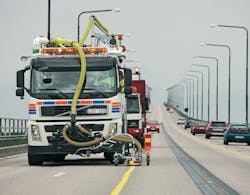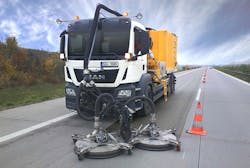Removing pavement markings from runways, aprons, gate areas, taxiways and the numerous paved surfaces around an airport complex has long been challenging, time intensive, and expensive. Traditionally, pavement marking removal has been done by grinding (milling). Other methods include shot blasting, sand blasting, soda blasting and gas torching. These processes often create a significant measure of scarring, dust, particulate debris, visibility and breathing hazards in the area. Water blasting provides a quick, clean, efficient, cost-effective and environmentally friendly method of marking removal.
What is Water Blasting?
Water blasting works by directing pressurized streams of water at a surface to accomplish a given task. The needlesharp water jets of a properly designed water blasting system will reach like tiny fingers into the pores or grooves of the asphalt or concrete with unmatched effectiveness.
Water blasting effectively strips the pavement marking material without damaging the surface underneath, making it the most desirable method for pavement marking removal worldwide.
What are the airport applications of a Water Blaster?
In this paper, we are illustrating the advantages of using water blasting to remove airport pavement markings, but water blasting systems are also used in many applications on a variety of surfaces including asphalt, concrete and metal.
Water blasting is frequently used in the following airport applications:
- Pavement marking removal.
- Runway rubber removal.
- Curing compound removal.
- Pavement marking rejuvenation and cleaning.
- Surface preparation before new markings are applied.
- Cleaining oil, jet-blast residue and grease from taxiways and gate areas.
How is Water Blasting used?
There are a variety of different pavement markings found at airports: Water-borne paints are most prevalent, but solvent-borne paints are used in certain conditions, as well as durable marking materials. These include epoxy, methyl methacrylate, and thermoplastic. Water blasting is the only method that can effectively remove all of these marking materials quickly, cleanly and with the least amount of negative impact to your paved surfaces.
While water blasting uses needle sharp water jets to reach into the pores of the asphalt with unmatched effectiveness, the surface plane of the asphalt remains intact. When driving over an area where a pavement marking was removed effectively by water blasting, you will not feel any change in the surface of the pavement.
Runway marking removal - Old runway markings were once covered in black paint when they needed to be removed. This practice is no longer acceptable, as it poses a potential safety risk. According to FAA Circular AC 150/5340-1L, Chapter 1.3. Surface Marking Practices.
“Pavement markings that are no longer needed are not to be painted over but instead are to be physically removed. The FAA does not endorse painting over the old markings because this inadequate practice merely preserves the old marking which, in some cases, has misled pilots and required extra maintenance. Physical removal of markings is achieved by water blasting, shot blasting, sand blasting or other acceptable means that do not harm the pavement.” [1]
The Problem with Other Removal Techniques
Water blasting is obviously not the only technique that can be used to remove pavement markings. Blasting with particulates and using mechanical means of removal can all effectively remove markings. However, they also present several significant problems when compared to water blasting.
Sand/Shot/Soda Blasting
This method uses highly abrasive particles to force marking material from the attached surface. This technique is effective at removing marking material from the surface, but it is very slow, more expensive and commonly causes potential Foreign Object Debris (FOD) hazard for aircraft.
Particulate blasting presents several safety concerns:
“Abrasive blasting with sands containing crystalline silica can cause serious or fatal respiratory disease” (CDC, 2014, para. 1). [2]
Contact with the skin may also cause burns, rashes, or irritation. This has necessitated the implementation of significant safety precautions when particulate blasting, including full body protection and respirator. Particulate blasting also raises the environmental concerns of air pollutants.
Mechanical Removal
This is the brute force method of pavement marking removal. In order for a grinder to remove imbedded marking material, it must remove the pavement to the lowest level of paint penetration. In many cases it involves the milling of the surface down to between 3 to 10 millimeters. This technique damages to the underlying surface to remove the marking. The resulting ruts can lead to an increase in accidents. Over time, successive grinding will cause enough damage to necessitate that the surface be repaved. In most cases, any surface that has been rutted during removal must be resurfaced due to the hazards presented.
On roadways surrounding airports aggressive milling has been cited in a number of accidents involving motorcycles, resulting in injuries and punitive fines to the contractors and the State or approving agency. In Martin Fagan, ET AL. V Black & Boucher, LLC, Et AL., the plaintiff was awarded $3.5 Million for injuries suffered when his motorcycle lost control due to irregularities caused by milling. [3]
The advantages of Water Blasting
Environmentally Friendly
With captive water blasting, two functions take place at the same time. First, removal and secondly, recovery. Operating at pressures up to 40,000 psi (2750 bar), the marking material is reduced to very fine particles by the needle sharp water jets. The simultaneous vacuum recovery ensures that all of the marking debris and the dispensed water are immediately recovered, ensuring that none of the debris particles are released into the surrounding atmosphere. Water blasting is the quickest, cleanest and most environmentally friendly form of airfield marking removal.
No Surface Damage
Water blasting only uses pure water at high pressure to remove pavement markings. That means that the surface will be completely intact after the process. Unlike milling, which will damage the surface over time, waterblasting done correctly will not negatively impact the micro-texture or macro-texture of the surface. In fact, waterblasting actually improves the macro-texture.
Safe and Non-Toxic
While particulate blasting and mechanical removal may pose a danger to workers and the environment, water blasting is safe and non-toxic. That means that it doesn’t require extensive safety precautions and can be done faster and more cost effectively than many other methods.
Faster Time to Completion
There’s no need for extensive prep work, safety measures, or waiting time with water blasting. Typically, water blasting is a one-person operation, and the surface will be ready for remarking within 15-20 minutes on a typical summer day.
- Water blasting is 60% faster than Sand Blasting
- Water blasting is 40% faster than Shot Blasting
Complete Marking Removal
Despite its gentler effect on the underlying surface, water blasting is exceptionally effective at removing all traces of markings. This is extremely important, as the remnants of old markings can confuse pilots, reducing the safety of airport paved surfaces.
Ready to Learn More?
Waterblasting Technologies’ Stripe Hog is the world’s leading brand of water blasting equipment with more units in use around the world than its 5 closest competitors combined. The Stripe Hog Waterblasting Systems provide a quick, safe, cost effective way to completely remove pavement markings, or perform any of the other applications, ensuring that your paved surfaces are more consistently and efficiently maintained.
If you’re interested in learning more about how water blasting can help simplify and improve the marking removal processes at your airport, schedule a demonstration today by contacting Waterblasting Technologies at 1-772-214-1714.
References
[1] Federal Aviation Administration (2013) Surface Marking Practices, Ch. 1.3. (FAA Circular AC 150/5340-1L), Washington, DC: US Government Printing Office.
[2] Centers for Disease Control (2014) Preventing Silicosis and Deaths from Sandblasting (1992, 2014) (DHHS (NIOSH) Publication Number 92-102). http://www.cdc.gov/niosh/docs/92-102/; Retrieved June 4, 2015.
[3] Martin Fagan, Et Al. V Black & Boucher, LLC, Et Al., (2014) Superior Court of the State of Connecticut, NNHCV116025092S. http://caselaw.findlaw.com/ct-superior-court/1660520.html; Retrieved June 4, 2015.
Editor's Note: Scranton Gillette Communications and the SGC Infrastructure Group are not liable for the accuracy, efficacy and validity of the claims made in this piece. The views expressed in this content do not reflect the position of the Roads & Bridges' Editorial Team.

